Bigfoot’s Killer-N 1102 Wireless Networking vs. the World
by Jarred Walton on August 10, 2011 10:38 AM ESTNetgear 2.4GHz Obstructed Performance
Our next test is the same router as before, only now we’ve moved the laptops to the opposite side of the house. For this test, the router is still upstairs, but the laptops are about 50 feet away (direct line) with several walls and a floor in between. As you might expect, performance is lower on every laptop in every test, though some controllers hold up better than others.
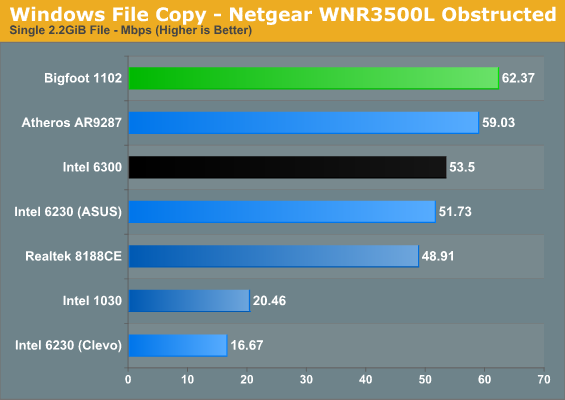
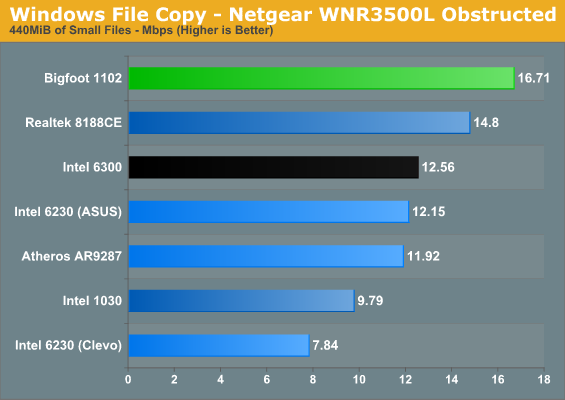
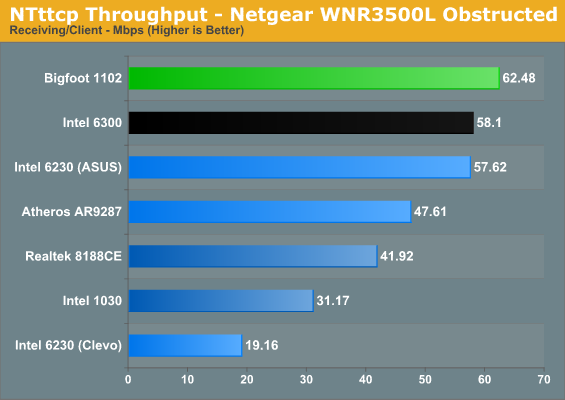
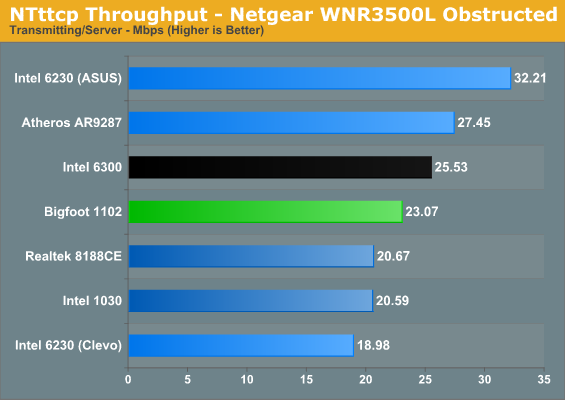
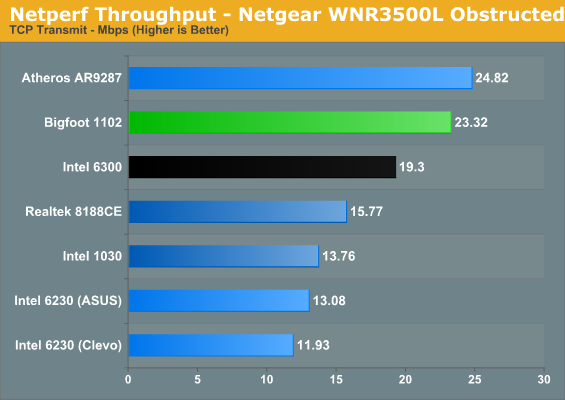
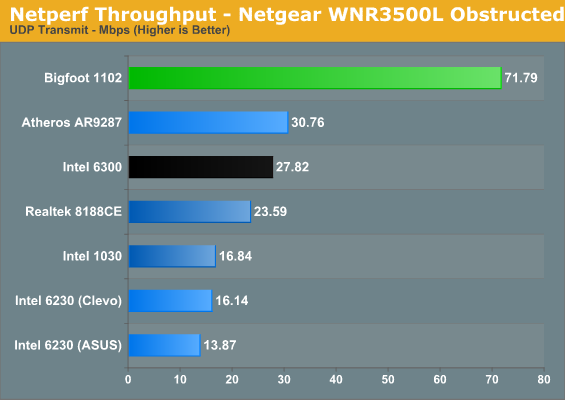
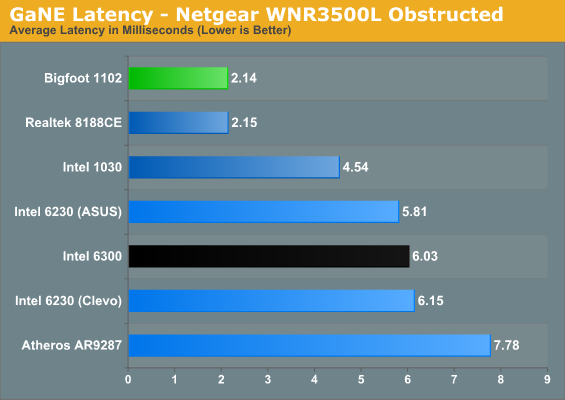
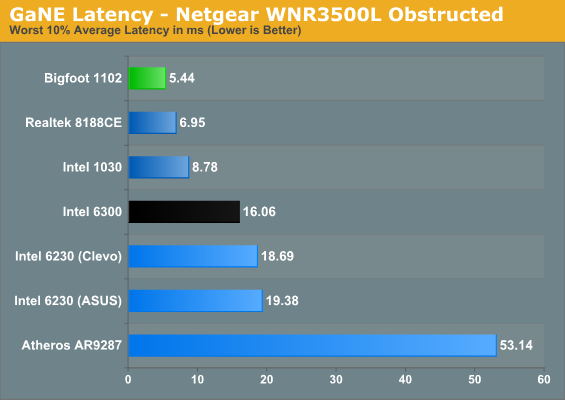
The Bigfoot 1102 leads in most of the tests, with the Realtek and Atheros generally claiming second and third. Once again, the ASUS K53E performs better than the Clevo sample unit in this test—much better in fact—despite both using the same Intel Advanced-N 6230 chipset. Also note that all of the cards do quite a bit better at receiving data than at transmitting (see the NTttcp charts), which makes sense as most laptops don’t put a ton of power into their transmit radios. It’s interesting that in our obstructed tests, the Intel 6230 (in the K53E) and 6300 along with the Atheros AR9287 all manage higher transmit rates than the BF 1102 with NTttcp, though that advantage doesn’t translate over to Netperf.
The Bigfoot 1102 still maintains a decisive lead in the latency tests, with the Realtek 8188CE nipping at its heels. Oddly enough, latency is actually lower on a couple of the cards (the K53E with Intel 6230 specifically), but that’s probably in part because the connection rate is no longer as high. Most of the laptops connected at less than 130Mbps, with a lot of variance in the speed as the cards frequently renegotiate their connections. Bigfoot also continues to dominate the copy time for lots of small files, again illustrating that their “secret low latency sauce” helps in areas other than gaming. The single stream Realtek chipset comes in second in that test, and it has the second lowest latency of the tested controllers.
The takeaway here is that even the best network cards won’t perform all that well without a clear signal. If you have a large house or office and you want to provide good coverage, setting up multiple access points would be necessary to obtain optimal performance for every room. We’ll look at how far the laptops can get from the router before experiencing connection problems later, but in most houses the Bigfoot 1102 should get a good signal.










52 Comments
View All Comments
zephon85 - Wednesday, August 10, 2011 - link
Any words on the impact of the different wifi adapters on notebook battery life? Would be quite good to know how much (if any) time you gain by using different wireless cards...Gigantopithecus - Wednesday, August 10, 2011 - link
I could be wrong but given the upper limit on mini-PCI and mini-PCIe power capacity, I'd assume differences between cards on the same interface would be negligible in the real world. You might be able to demonstrate small statistically significant differences between cards using large sample sizes and very rigorous, controlled testing, but that's an enormous amount of time and effort to show that card X yields 5-6 more minutes of battery runtime than card Y.JarredWalton - Wednesday, August 10, 2011 - link
I'll cover the battery life question in the laptop review; I didn't actually take the time to perform those tests yet. I don't expect much of a difference, as WiFi adapters are usually pulling less than 250mW, but we'll see.Souka - Wednesday, August 10, 2011 - link
I'll put my $.02 in.Different cards have different drivers....each with their own defaul power settings.
Unless all the various options are taken into account, it can be really hard to get a apples-2-apples comparison of power needs.
But I agree to a point, the wi-fi power draw is really low compared to drive, memory, cpu, gpu, and LCD power needs.
Kinda think of driving a car with the antenna up vs down.... yes it does make a difference, but not much.
My $.02
:)
SquattingDog - Wednesday, August 10, 2011 - link
Just to post on this - Wireless being on or off can make a huge difference to battery life on notebooks - so some testing between cards could definitely be good. Eg on a Netbook I have (Asus n10jc), I typically get around 30 - 45min more battery life with wifi OFF.In saying that, since upgrading from a 54mbps wifi network to a 300mbps wifi network, I have seen no difference in battery usage on the machine (connects at 300Mbps now).
JarredWalton - Wednesday, August 10, 2011 - link
True, but you're looking at a netbook that idles at around 7W. A reduction in power draw of .25W would be a lot more noticeable on that than on a full laptop that's drawing 12-15W minimum.Souka - Wednesday, August 10, 2011 - link
with wi-fi on you may have a fair amount of network activity going on...which also increases the draw by the cpu/drive/mb/etcanyhow...good points all! :)
philosofool - Wednesday, August 10, 2011 - link
Wireless networking isn't something I really keep up on, so I don't know much past the various 802.11 names. What, forexample, does 3x3:3 mean and why might I like that more than some other configuration?A5 - Wednesday, August 10, 2011 - link
From Page 1 of the review:"While we’re on the subject, let’s clarify what the MIMO numbers mean. When we’re talking about a 2x2:2 part, the first digit is the number of transmit chains, the second is the total number of receive chains, and the third is the total number of data streams supported. It’s possible to have a 3x3:2 device, for example, which would use the extra transmit and receive chains to improve SNR (Signal to Noise Ratio), but the number of streams cannot be more than the larger of the transmit/receive chains (so 2x2:3 isn’t possible, but 2x3:3 is)."
Theoretically, a 3x3:3 device offers 3x the bandwidth of a 1x1:1 device.
GeorgeH - Wednesday, August 10, 2011 - link
Thanks for the review, it looks like my bias against everything "killer" will have to be adjusted a bit. While I'm still not sure that the performance difference is terribly meaningful, neither is $20 in most laptops.